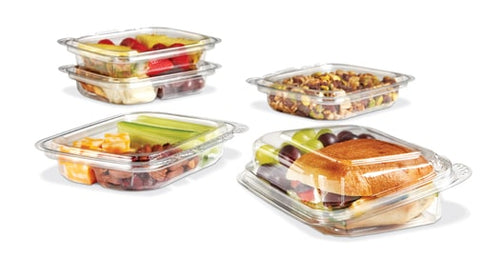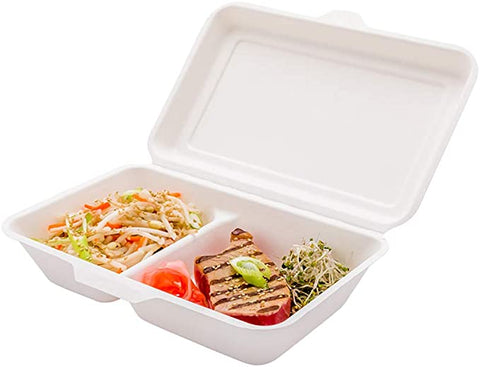"Shop Here"

Types d’emballages alimentaires écologiques
Passer des contenants en polystyrène et des sacs en plastique à usage unique à davantage produits jetables écologiques est un moyen simple pour votre entreprise de réduire son impact environnemental tout en attirant vos clients. Que vous recherchiez des matériaux écologiques pour vous aligner sur votre menu durable ou pour vous conformer aux nouvelles réglementations, il existe une solution d'emballage alimentaire écologique pour vous !
Types d'alternatives écologiques aux contenants à emporter en polystyrène
Des options réutilisables aux matériaux en plastique et papier recyclés ou entièrement à base de plantes
Le plastique PET (polyéthylène téréphtalate) est un plastique solide, léger et transparent qui ne réagit pas avec les produits alimentaires, ce qui en fait une option populaire et rentable pour emballer des aliments et des boissons. De plus, en raison de sa capacité à être recyclé plusieurs fois pour créer de nouveaux produits, le plastique PET est un plastique économe en énergie et de nombreux contenants alimentaires sont souvent fabriqués à partir de contenu recyclé.
- Construction durable et incassable
- La plupart vont au congélateur, ce qui les rend parfaits pour transporter des aliments froids
- 100 % recyclable ; le plastique le plus facilement et le plus couramment recyclé
- Sans BPA
- Dérivé de plastiques recyclés à base de pétrole

Récipients en plastique PLA
- Convient aux applications chaudes et froides
- A une empreinte carbone plus faible que les plastiques traditionnels
- Sans BPA
- Uniquement compostable dans des conditions de compostage industriel
- Tous les plastiques PLA ne sont pas créés égaux : certaines cultures utilisées pour créer les plastiques pourraient avoir été cultivées avec des engrais et des pesticides non respectueux de l'environnement.
- Parce qu’ils sont chimiquement différents, ils doivent être correctement recyclés, séparément des plastiques traditionnels ; recyclable #7

Conteneurs de canne à sucre / bagasse
La canne à sucre/bagasse est un matériau renouvelable à base de plantes, sans arbres, fabriqué à partir des déchets de plantes de canne à sucre qui restent après l'extraction du sucre. Ce matériau fibreux et pulpeux est utilisé pour créer des contenants durables qui séduisent les consommateurs soucieux de l'environnement et dont la production nécessite beaucoup moins d'énergie que les produits en plastique.- Convient aux applications chaudes et froides
- Assez robuste pour gérer les aliments gras
- 100% biodégradable et compostable
- Passe au micro-ondes et au réfrigérateur
- La conception non blanchie ne contient pas de colorants toxiques
- Doit être composté dans une installation de compostage commerciale
- Plus coûteux que les autres alternatives à la mousse

- Résistants aux fuites et à la graisse, ce qui les rend suffisamment solides pour résister aux sauces, aux sauces et aux huiles
- Respirant pour laisser s'échapper la vapeur et l'humidité et empêcher les aliments de devenir détrempés
- La couleur kraft naturelle ne contient pas de colorants toxiques
- Recyclable et contient généralement du contenu recyclé
- Le revêtement poly rend le matériau plus difficile à recycler
- Ne peut pas provenir de forêts gérées durablement
- Construction durable et résistante aux coupures
- Non absorbants et résistants aux fuites, ce qui les rend parfaits pour contenir des aliments en sauce
- Convient aux applications chaudes et froides
- Passe au micro-ondes
- Recyclables en fin de vie
- Toujours fabriqué avec une matière plastique non renouvelable

Conteneurs réutilisables en polypropylène
- 100% sans BPA
- Passe au micro-ondes et au lave-vaisselle
- Conception durable, incassable et résistante aux fuites
- Chaque conteneur peut être utilisé jusqu'à 1000 utilisations
- Recyclables en fin de vie
- Coût initial plus élevé que les autres options écologiques
- Ce n'est pas une option rentable pour les entreprises situées dans des endroits plus touristiques ou dans des endroits qui servent principalement des clients qui ne sont pas susceptibles de revenir fréquemment.

Conteneurs en fibre de pâte moulée
- Fabriqué à partir de contenu recyclé et de ressources renouvelables
- Généralement biodégradable et/ou compostable
- Ne contiennent généralement pas d'additifs chimiques, de revêtements ou de colorants
- Toutes les pâtes moulées ne sont pas égales en raison des propriétés des différentes fibres utilisées.
Types d'alternatives écologiques aux sacs en plastique
Si vous choisissez de passer à des contenants plus écologiques pour votre service de plats à emporter, il est également judicieux d'envisager de modifier d'autres articles impliqués dans votre système de livraison afin de maintenir la cohérence de votre marque auprès des consommateurs. Plusieurs produits écologiques sont disponibles pour vous aider à remplacer définitivement les sacs de plastique à usage unique dans votre établissement.- 100% biodégradable et recyclable. Il existe également des options certifiées compostables.
- Peut généralement résister à plus de pression ou de poids que les sacs en plastique
- Les temps peuvent souvent être réutilisés
- Généralement plus cher que les sacs en plastique
- Ne peut pas provenir de forêts gérées durablement

Sacs en plastique réutilisables
Les sacs en plastique réutilisables sont une excellente option pour les entreprises qui cherchent à passer à des options plus respectueuses de l'environnement sans compromettre la durabilité ou la flexibilité des sacs en plastique traditionnels. De plus, les sacs en plastique réutilisables sont faciles à nettoyer avec une lingette hygiénique.- Fabriqué avec des plastiques HDPE ou LDPE recyclables et durables
- Souvent accepté dans les programmes locaux de collecte sélective
- Options biodégradables
- Solution économique aux sacs en plastique à usage unique
- Toujours fabriqué avec une matière plastique non renouvelable

Boîtes à emporter
- Construction en carton résistant à la graisse
- Respirant pour laisser s'échapper la vapeur et l'humidité et empêcher les aliments de devenir détrempés
- Options recyclables et compostables
- Ne peut pas provenir de forêts gérées durablement
Pourquoi passer aux alternatives à la mousse de polystyrène ?

La mousse de polystyrène est un matériau de marque couramment utilisé pour classer tous les types de produits en mousse de polystyrène expansé (PSE). Les produits en polystyrène sont recyclables et sont marqué du numéro recyclable "6" . Cependant, ces produits sont très rarement réellement recyclés. Peu de gouvernements locaux acceptent les produits en polystyrène dans les bacs de recyclage en bordure de rue, et rares sont les centres de recyclage qui acceptent et recyclent la mousse de polystyrène, car cela peut être un processus difficile et coûteux. En conséquence, la mousse de polystyrène est devenue un problème environnemental majeur pour plusieurs raisons :
- La mousse de polystyrène n'est pas biodégradable, ce qui signifie qu'elle ne se dégrade pas naturellement avec le temps et qu'elle occupe environ un tiers de l'espace d'enfouissement mondial.
- Souvent, les produits en mousse de polystyrène se décomposent en morceaux plus petits qui polluent les terres et les eaux, ce qui constitue une menace pour la faune et rend les efforts de nettoyage difficiles.
- Des études suggèrent que le styrène, l'ingrédient principal de la mousse de polystyrène, est probablement un cancérigène pour l'homme qui peut causer des problèmes de santé en cas d'exposition prolongée.



